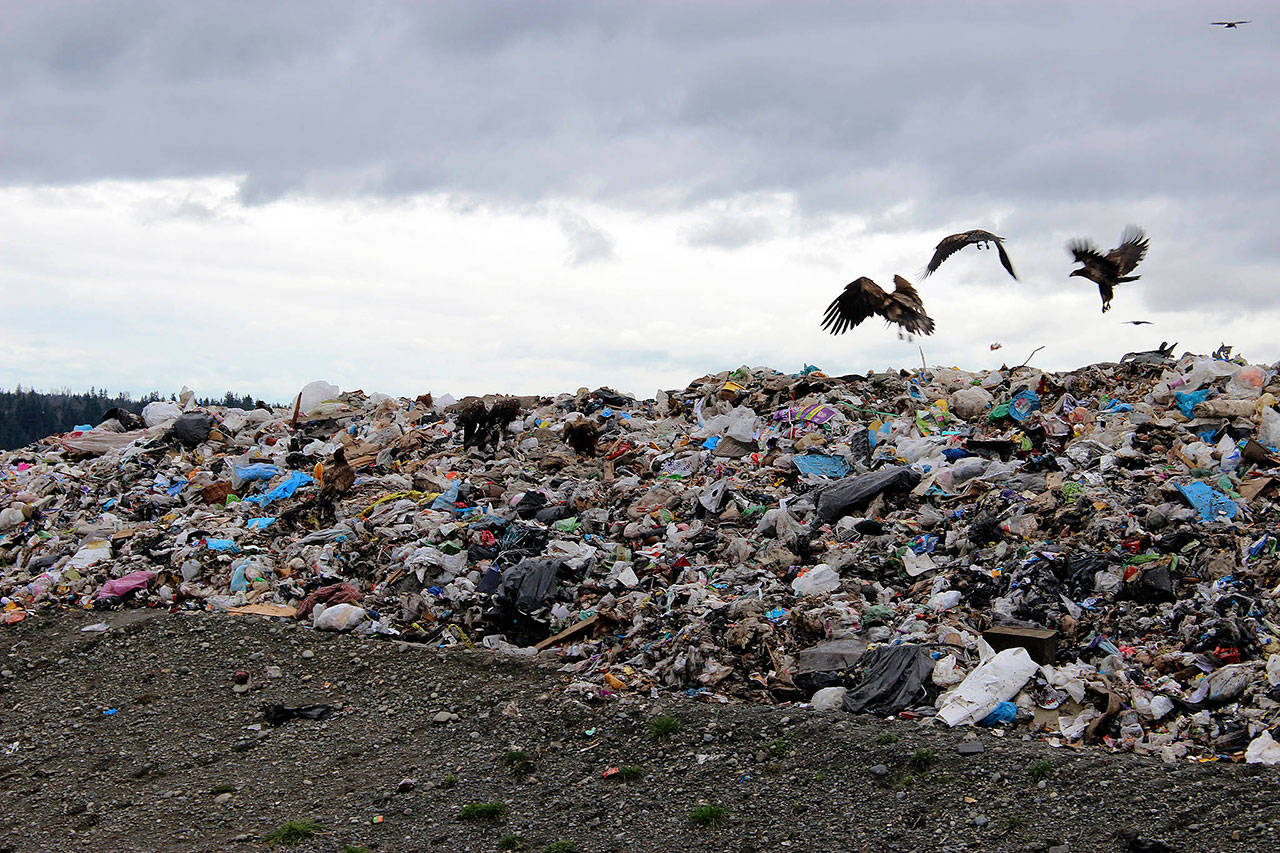King County Executive Dow Constantine wants to expand capacity at the Cedar Hills Regional Landfill in Maple Valley to handle garbage from the county and its 37 partner cities, including Kent, to at least 2040.
Pat McLaughlin, director of the King County Solid Waste Division, told the Kent City Council’s Public Works Committee on Aug. 20 that the 920-acre landfill will reach capacity by 2028.
Constantine has forwarded a Solid Waste Comprehensive Plan to the County Council with three long-term disposal options, including his recommendation to expand capacity with a redesign of the landfill, which opened in the mid-1960s:
• Develop additional capacity at Cedar Hills to maximize space there: Capital cost of $241 million; annual operating cost of $29 million
• Export waste to an out-of-county landfill via rail: Capital cost of $5 million; annual operating cost of $72 million
• Build a waste-to-energy (mass burn) facility somewhere in King County: Capital cost of $1.8 billion; annual operating cost of $72 million
“They have to begin planning for an alternative to be ready by that time (2028),” said Kent City Councilman Dennis Higgins, chair of the Public Works Committee, in a report to the city council. “It’s not easy to find a place to put garbage.”
The proposal will go to the county council for approval, possibly before the end of the year. Each city will then vote – possibly early next year – on the county council’s plan. King County owns and operates the landfill. Cities contract with the county to use the landfill. All waste collected at the county’s eight transfer stations is transported to the landfill.
“There would be rate increases to pay for it – a hike in the garbage bill,” Higgins said. “It would be about 4 percent per year for the next 10 years to pay for expansion.”
A Kent resident with a 32-gallon waste container now pays $18.56 per month. That would jump to about $19.30 per month in the first year of the increase and continue to go up in each of the next nine years for total jump of about $9.20 per month by 2019 to pay for the landfill expansion. The public will have a chance to comment about the proposal when it goes before the county council and the city councils.
The other two alternatives are more expensive.
The city of Seattle uses rail to haul garbage to a landfill in Eastern Oregon.
Tim LaPorte, city of Kent Public Works director, told the committee that he talked to Mayor Dana Ralph about the options.
“We met earlier and are not in favor of using rail because it puts us at the mercy of the rail and capacity is so limited with the need for freight and passenger,” LaPorte said. “We didn’t see it as a good resource that we could depend on for the future.”
McLaughlin said because the county already owns the landfill – that’s an advantage for the expansion option.
“We’ve been doing this business for over 50 years and we’re pretty good at it,” he said.
McLaughlin said using rail would mean contracting a portion of the business to the private sector.
“To export, our concerns are capacity,” he said. “There is enough rail and a destination, but in between are a concern with rail traffic, constraints on railway and routes above capacity.”
Potential landfill sites include Columbia Ridge and Finley Buttes in Eastern Oregon; Roosevelt Regional in Klickitat County in Eastern Washington; and Simco Road in Idaho.
The costs to build a waste-to-energy facility would be roughly $1.8 billion. The county also would have to find a site for the plant. The county could sell the energy to help offset the capital costs.
“This is not just a financial decision,” McLaughlin said. “We also looked at the environmental impact. All three options are viable, with certain risks.”
The expansion of the landfill would require a State Environmental Policy Act (SEPA) review and go through an extensive permitting process.
“And we have neighbors (to the landfill), so we anticipate challenges to the process,” McLaughlin said.
If approved by county and city leaders, work on the landfill expansion could begin in 2019 with the design phase, McLaughlin said.
Any expansion approved at the landfill would be the final time to increase capacity because then that land would be filled. So in another 10 years or so the county and cities will need another plan for where to put its garbage, which could be haul away by rail or the mass burn facility.
The landfill currently receives about 2,800 tons of garbage per day or more than 100 truckloads. McLaughlin said forecasts because of population growth show that amount increasing to 5,000 tons per day, more than any present-day burn plant could handle.
“No energy facility in the world can handle that much,” McLaughlin said. “But there are plants being designed in Dubai and China that large.”
Constantine, County Councilmember Kathy Lambert and Budget Director Dwight Dively traveled to Florida in June to view a waste-to-energy plant built in 2015, McLaughlin said.
“The result of the trip was affirmation that waste-to-energy works – it’s a viable and responsible way to dispose of materials,” McLaughlin said. “They sell energy to offset costs. But with hydro power here pretty affordable compared to coal plants that serve other parts of the country, the ability to offset costs is reduced here.
“This proposal (to expand the landfill) recommends we move forward maximizing our current asset and leaves open possibilities to what is next.”
Talk to us
Please share your story tips by emailing editor@kentreporter.com.
To share your opinion for publication, submit a letter through our website https://www.kentreporter.com/submit-letter/. Include your name, address and daytime phone number. (We’ll only publish your name and hometown.) Please keep letters to 300 words or less.

